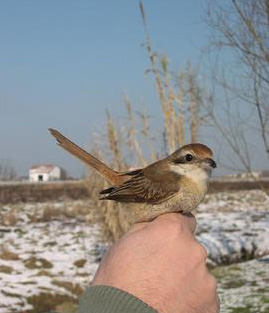BROWN SHRIKE – LANIUS CRISTATUS – AVERLA BRUNA – 2003 JANUARY 12 – THE FIRST WINTERING IN EUROPE

First record for Brown Shrike Lanius cristatus in Italy – La Tomina – MODENA 2003, January 12
This recording was performed at La tomina, in the municipality of Mirandola (MO) – Italy. I used a Telinga Parabolic Microphone Twin Science and a Sony Minidisc MZR50. The recording was filtered for the low frequencies.
See: Giannella C., Gemmato R., Pesente M. & Longhi D. 2003. The Brown Shrike in Italy. – the first wintering in Europe. Birding World 16(3): 126-128.
Carlo Giannella, Raffaele Gemmato, Marco Pesente and Daniele Longhi
BIRDING WORLD Volume 16 Number 3 – 126-128Download
Since that morning of January 12, 2003, the Shrike had been spotted by other observers for a few days already, however it had been mistaken, from the other, also for a Red-Backed Shrike, Lanius collurio. As soon as I arrived on the spot, I was pleased to notice that I was alone. I was lucky enough to be able to observe the bird well from close range, while it was eating a little mouse that it had previously stuck on a thorn of the bush where it was having her meal. The ground around it was completely covered with snow. I started making a movie with an old video camera that I had taken with me; back then there was still no possibility to make movies with reflex cameras, so I had to settle for what I had available, an old Sony Video8.
As soon as the meal was over, the shrike began to sing emitting a sort of sub-song; I immediately put to work the Telinga Twin Science parabolic microphone combined with the Sony MZ R50 MiniDisc.
I also had time to take some photos, testifying to the species, or at least of what I thought it might be a species, to me an Isabelline Lanius isabellinus Isabelline Shrike.
This done, I went to what was then the Ringing Center called “La Tomina”, due to the location where the research station was located. There I met the friends of mine Raffaele Gemmato and Carlo Giannella, while they were carrying out maintenance work on the mist nets. I told them what I had seen and what I had done, I asked if they had tried to capture that bird in order to verify its species and then ring it. To the negative response, I stimulated in them the desire to try to trap the bird, saying that I had with me both the audio recording just performed, and a small speaker to try to call it near the mist nets through its own song using the playback. We looked each other in the eyes and, in no time at all, we took a couple of mist nets and went to the place of my last sighting, we quickly mounted the mist nets and we turned on the the playback through the same MiniDisc I used for the recording.
If I say that it was four minutes before having her jumped into the net exactly where the call came from playback … well I don’t exaggerate!
Happy to have achieved what we had set for ourselves, we quickly disassembled the mist nets and went to the ringing center, where we performed the ritual operations: measurements, control of the moulting status of the plumage, of the body fat, but above all of the identification of the species. This last thing was by no means taken for granted, even if at the time we thought of attributing it, as a species, to an Isabelline Shrike, if only for a calculation of probability, compared to other probable species. After taking some photos of the specimen in hand, in order to have the greatest number of details subsequently available, we released the subject, not before putting her well-deserved ring on its!
Each of us has returned to his home. I more than the others were away from home, about 60 kilometers. As soon as I arrived, I began to consult various publications, including obviously what was then (but in some respects still is) our bible: the Cramp! Look and look, the accounts did not add up; there was something in the shape, and therefore in the measures, of the tail which did not match what we believed to be the kind of belonging of the subject just checked, namely having it Isabelline Shrike. “Do you want to see that it’s about…”, I don’t have time to think that the phone is ringing. He is Carlo Giannella, who promptly manifests their (his and Raffaele Gemmato’s) doubts, which coincidentally follow mine; we confront each other for a moment to express our perplexities, but also to advance what, separately but I would say at the same time simultaneously, we have formulated as the next specific hypothesis: a Brown Shrike!
And this was it!!!
Photos and video by Marco Pesente
Versione in italiano
Prima di quella mattina del 12 gennaio 2003, l’Averla era stata avvistata, da altri osservatori, già da alcuni giorni, tuttavia era stata scambiata, tra le altre, anche per un’Averla piccola, Red-Backed Shrike, Lanius collurio. Appena arrivato sul posto, notai con piacere che ero da solo. Ebbi la fortuna di poterla osservare bene da distanza ravvicinata, mentre stava mangiando un piccolo roditore che aveva preventivamente infilzato su di una spina del cespuglio dove stava consumando il pasto. Il terreno all’intorno era completamente coperto di neve. Iniziai a filmare con una vecchia videocamera che avevo preso con me; all’epoca non c’era ancora la possibilità di riprendere filmati con le fotocamere reflex, per cui mi dovetti accontentare di ciò che avevo a disposizione, una vecchia Video8 Sony.
Non appena terminato il pasto, l’Averla iniziò a cantare emettendo una sorta di sottocanto; immediatamente misi all’opera il microfono parabolico Telinga Twin Science abbinato al MiniDisc Sony MZ R50.
Ebbi anche il tempo per scattare qualche foto, a testimonianza della specie, o perlomeno di quella che pensavo potesse trattarsi come specie, ossia un’Averla isabellina, Lanius isabellinus.
Ciò fatto, mi recai presso quello che allora era il Centro di Inanellamento denominato “La Tomina”, per via della località in cui veniva a trovarsi la stazione di ricerca. Lì incontrai gli amici Raffaele Gemmato e Carlo Giannella, mentre stavano effettuando dei lavori di manutenzione alle reti. Dissi loro quello che avevo visto e ciò che avevo fatto, chiesi se avessero provato a catturarla per verificarne la specie e quindi inanellarla. Alla risposta negativa, stimolai in loro la voglia di provare a prendere la bestia in questione, dicendo che avevo con me disponibili, sia la registrazione audio appena eseguita, sia un piccolo altoparlante per provare a richiamarla in prossimità delle mist nets tramite il suo stesso canto. Ci guardammo negli occhi e, in men che non si dica, prendemmo un paio di mist nets, ci recammo sul posto dell’ultimo mio avvistamento, stendemmo velocemente le reti e mettemmo in funzione il richiamo in playback tramite lo stesso MiniDisc utilizzato per la registrazione.
Se dico che passarono quattro minuti prima che l’averla si tuffasse in rete esattamente da dove proveniva il richiamo in playback… beh non esagero!
Felici di aver ottenuto ciò che ci eravamo prefissati, smontammo velocemente le reti e andammo presso il centro di inanellamento, dove compimmo le operazioni di rito: misurazioni, controllo dello stato di muta del piumaggio, del grasso corporeo, ma soprattutto dell’identificazione della specie. Quest’ultima cosa non fu per nulla scontata, anche se lì per lì pensammo di attribuirla, come specie, all’Averla isabellina, non fosse altro per un calcolo di probabilità, rispetto ad altre probabili specie. Dopo aver scattato alcune foto all’esemplare in mano, per avere il maggior numero di particolari successivamente disponibili, rilasciammo il soggetto, non prima di avergli apposto il suo meritato anellino!
Tornammo ognuno alla propria abitazione, io più degli altri mi trovavo lontano da casa, a circa 60 chilometri. Non appena arrivato, mi misi a consultare varie pubblicazioni, tra cui ovviamente quella che allora era (ma per certi aspetti ancora adesso lo è) la nostra bibbia: il Cramp! Guarda e riguarda, i conti non tornavano; c’era un qualcosa nella forma, e quindi nelle misure della coda, che non combaciava con quella che ritenevamo essere la specie di appartenenza del soggetto appena controllato, ossia l’Averla isabellina. “Vuoi vedere che si tratta di…”, non faccio in tempo a pensarlo che squilla il telefono. E’ Carlo Giannella, prontamente mi manifesta i loro (suoi e di Raffaele Gemmato) dubbi, che guarda caso ricalcano i miei; ci confrontiamo un attimo per manifestarci sì le perplessità, ma anche per avanzare quella che, separatamente ma direi al tempo stesso simultaneamente, abbiamo formulato come successiva ipotesi specifica: un’Averla bruna, Lanius cristatus!!!
E così fu!

Commenti recenti